Advertisements
Advertisements
प्रश्न
Give an account of the occupational structure of India’s population.
उत्तर
The population of India according to their economic status is divided into three groups, namely; main workers, marginal workers, and non-workers. It is observed that in India, the proportion of workers (both main and marginal) is only 39 percent (2001) leaving a vast majority of 61 percent as non-workers. This indicates an economic status in which there is a larger proportion of the dependent population, further indicating the possible existence of a large number of unemployed or under-employed people.
The occupational composition of India’s population (which actually means engagement of an individual in farming, manufacturing trade, services, or any kind of professional activities) shows a large proportion of primary sector workers compared to secondary and tertiary sectors. About 58.2 per cent of the total working population are cultivators and agricultural labourers, whereas only 4.2% of workers are engaged in household industries and 37.6% are other workers including non-household industries, trade, commerce, construction and repair and others. services. As far as the occupation of the country’s male and female population is concerned, male workers outnumber female workers in all three sectors. The number of female workers is relatively high in the primary sector, though in recent years there has been some improvement in the work participation of women in secondary and tertiary sectors.
The participation rate in secondary and tertiary sectors has registered an increase. This indicates a shift of dependence of workers from farm-based occupations to non-farm-based ones, indicating a sectoral shift in the economy of the country. The spatial variation of work participation rate in different sectors in the country is very wide. For instance, the states like Himachal Pradesh and Nagaland have very large shares of cultivators. On the other hand states like Andhra Pradesh, Chhattisgarh, Odisha, Jharkhand, West Bengal and Madhya Pradesh have a higher proportion of agricultural labourers. The highly urbanized areas like Delhi, Chandigarh and Puducherry have a very large proportion of workers being engaged in other services.
APPEARS IN
संबंधित प्रश्न
Identify the correct co-relation:
A: Assertion; R: Reasoning
A: Increase in the dependency ratio will affect the economy.
R: Medical costs are high when there are more elderly in the population.
Give a geographical reason:
In developed countries, the percentage of the population engaged in agriculture is low.
Give geographical reasons:
Literacy rate of a country is an indicator of its socio-economic development.
Differentiate between:
Expansive population pyramid and Constrictive population pyramid.
Broad base with narrowing apex shows that more people die at each higher band. It shows ______.
A person who can write, read and do mathematical calculations in the country is known as ______.
Complete the chain
| Sr. No. | A | B | C |
| 1. | Expansive age pyramid | Low birth-death rate | High medical expenses |
| 2. | Constrictive age pyramid | Human capital | Unwillingness |
| 3. | Stationery age pyramid | Low number of old people | Demographic dividend |
| 4. | High working population | Problem of subsistence | Developed country |
| 5. | Migration due to drought | High number of old people | Economically backward |
Identify the incorrect factor
Type of age-sex pyramid:
Identify the incorrect factor
Factors having direct relation with literacy:
State whether right or wrong:
Literacy ratio of population is indicator of economic and social development of a country.
Write short note
Rural-urban structure of population
Which states have a large rural population in India? Give one reason for such a large rural population.
‘The agricultural sector has the largest share of Indian workers.’ – Explain.
Why have many European countries have deficit males?
What does the literacy rate of a country indicate?
How does the sex ratio give important information about the status of women in a country?
How is sex ratio calculated in different countries of the world?
Why is sex ratio in some European countries recorded favourable to females? Give one reason.
“In some countries of the world, the sex ratio is unfavourable to women.” Give one reason.
“In some countries of the world, the sex ratio is unfavourable to women.” Give one reason.
Where does India rank in the world as regards area?
What is life expectancy in India?
Which state has the lowest sex ratio?
A worker is known as main worker, who works atleast ____________.
Broad base of age-sex pyramid refers to ______.
Which attribute does not distinguish people?
Favourable sex ratio is found in how many countries.
In European countries, a deficit of males is due to ______.
According to the UNO, how many countries have sex ratio favourable for females?
According to the UNO, how many countries have sex ratio unfavourable for females?
The largest country in Asia Continent in terms of area ______
The second largest country in Asia Continent in terms of area ______
Study the given graph carefully and answer the following question:

Intra-state Migration by place of Last Residence Indicating Migration Streams India, 2011

Inter-state Migration by Place of Last Residence Indicating Migration Streams India, 2011
Which stream of migration shows the lowest trend in interstate migration?
Table: India-Class-wise number of towns and cities and their population, 2011
| Class | Population Size | Number of Cities | Total Urban Population (in thousands) | % of Total Urban Population |
| I | 1,00,000 & more | 568 | 2,27,899 | 60-45 |
| II | 50,000-99,999 | 474 | 41,328 | 10-96 |
| III | 20,000-49,999 | 1,373 | 58,174 | 15-43 |
| IV | 10,000-19,999 | 1,683 | 31,866 | 8-45 |
| V | 5,000-9,999 | 1,749 | 15,883 | 4-21 |
| VI | less than 5,000 | 424 | 1,956 | 0-52 |
Source: Census of India-2011 and India 2017, Ministry of Information and Broadcasting, Government of India.
Which class town has the maximum urban population?
Study the given graph carefully and answer the following question:

Intra-state Migration by place of Last Residence Indicating Migration Streams India, 2011

Inter-state Migration by Place of Last Residence Indicating Migration Streams India, 2011
What is the main cause of female migration from rural to urban?
Table: India-Class-wise number of towns and cities and their population, 2011
| Class | Population Size | Number of Cities | Total Urban Population (in thousands) | % of Total Urban Population |
| I | 1,00,000 & more | 568 | 2,27,899 | 60-45 |
| II | 50,000-99,999 | 474 | 41,328 | 10-96 |
| III | 20,000-49,999 | 1,373 | 58,174 | 15-43 |
| IV | 10,000-19,999 | 1,683 | 31,866 | 8-45 |
| V | 5,000-9,999 | 1,749 | 15,883 | 4-21 |
| VI | less than 5,000 | 424 | 1,956 | 0-52 |
Source: Census of India-2011 and India 2017, Ministry of Information and Broadcasting, Government of India.
Which class town has the minimum urban population?
The highest sex ratio is found in:
The developed countries having low birth and death rates come under which category?
The sex ratio in a country can be expressed as which of the following?
Which of the following is true about age sex pyramid?
- It depicts number of males and females in different age groups.
- It is of various shapes, depending upon the population of a country.
- Age-sex pyramid of Bangladesh and Mexico are similar.
Match the following and choose the correct option.
| Population | Pyramid shape |
| A. Constant population | 1. Perfect triangle shape |
| B. Declining population | 2. Bell shape |
| C. Expanding population | 3. Narrow Base & Tapered Top Shape |
Which group is known as productive group?
A country having pyramid of population that has a wide base and sharply tapered top is characterised by which of the following?
Which one of the following is the largest linguistic group of India?
Which one of the following is the largest linguistic group of India?
Which one of the following is the largest linguistic group of India?
Which one of the following is the largest linguistic group of India?
Which one of the following is the largest linguistic group of India?
Which one of the following is the largest linguistic group of India?
